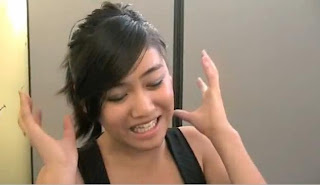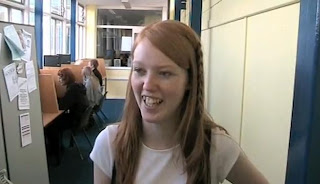
0:31 – Shot-reverse shot uses mid-close up so that facial expressions are clear and provides shot variety.

0:34 – Here it displays expression clearly and also establishes the scenery from the background. Whilst keeping to the rule of thirds, the shot has a more professional and dynamic look.
On the other hand, it also develops the shot-reverse shot because the character (Agent 2) and the camera move simultaneously so that Agent 2 walks into the reverse shot. (Refer to prelim video: 0:26 – 0:32.)
The 180 degree rule ensures that the viewer’s sense of proportion is natural when watching as it keeps the same left/right relationship between characters. If the camera passes over the imaginary axis connecting the subjects, sense of proportion and continuity is distorted. In the prelim, it follows this rule and keeps with the convention so that it makes sense and the scenes flow. However in “Catch Them All” the line is crossed in the corridor scene during the over-shoulder shot.
This is how the prelim crossed the 180-degree rule line.
0:45
0:51
This diagram represents how it should have looked.
0:45
0:51
This following diagram shows how the camera positoned in the over-shoulder shot had crossed the line from a birds-eye view.
The Match on Action shot takes place between 1:03 – 1:06. It gives a sense of continuity and realism to the film. During filming this shot was taken in four different scenes that were cut down and put together to create one flowing movement. A close up of the handle clicking down and up from both sides of the door was done so that the audience feels like their sweeping through the scene from both Agent 1’s point of view and the Boss on the other side of the door.
In the majority of the prelim Camera framing is done suitably. Framing is essential as it means including relevant or logical scenery within the camera’s view. For example, if someone is walking down a corridor, the camera needs to be a certain distance away from the character so that when framed, there is part of the floor visible for the character to walk into. If camera is framed too close otherwise, it will look like the character is stationary when he/she is meant to be walking. In the prelim, there were exceptions within camera framing, such as…
1:03 – This shot is a close up from the side of the head. Conventionally close ups show the face but this shot does not as it is meant to show the movement of the character. It poses not other purpose than that as it does not establish backgrounds well.
1:07 – Here the framing is developed as it cuts off the Boss’ head. This is done on purpose so that his face remains hidden. The shot is a combination of over shoulder, mid-close up, and practices the rule of thirds.
During post production the following mistake was found...

As the Agents walk round the corner to the left from right in the corridor at the end of that scene, we edited it so that the scene was cut straight to Agent 1 walking up to the boss' office, framed so that the walked from right to left.
It was later clarified that this was wrong in terms of continuity and camera framing.
In the future I will be sure to set out shots and camera positioning and carefully chekcing them before filming.
The following are the Camera Shots and Angles were used:
A mid-close up tracking shot is used here. It keeps the body and face hidden to evoke mystery and curiosity. The jagged tracking and running implies the character is caught in a chase. The black and white in the victim scenes such as this also implies the shot to be a flash back or memory. 
The Point of View shot here shows continuity as it shows the set where the victim is running at. The pace of the running and the off-balanced framing displays the urgency of the character and creates suspense.
A long shot of the corridor can become an establishing shot as it shows the background scenery well. From the moment it fades into the scene the audience has the impression of an office from the corridor, the desks, and pin board, as well as a full body costume.
Following up the long shot, a mid shot gives more information on the characters and clearly shows the dialogue between them. It also reveals that they are walking because of the backwards tracking; showing the background mise-en-scene moving further away.
This shot potentially challenges the conventions of shots as it is a medium shot of the landscape but the subject in it, is not framed at any point of the scene. The character vaults and because he moves in and out of the frame there is not definite shot of the character.
The shot here is a low angled close up of the subject vaulting a short fence. It is a dynamic shot as it includes scenic clouds and provides a different angle to the victim’s chase scene.
This is the victim scene's mid-long shot pan. A pan of the victim running from top of stairs then jumping it makes everyhting look quicker, creating tension and suspense needed.
A standard over the shoulder shot gives information on who the characters are talking too, and also shows their expression in reply to the dialogue. It is used here so that the difference between the character’s personalities is clear. Agent 2 is less experienced in assassination therefore it was important to show her expressions with the nervous voice to give the character more depth.
Both agents in this medium shot walk out of the camera frame, giving continuity to the scene. It also clearly shows Agent 1 spinning around Agent 1, revealing her confident and leader-like attitude and Agent 2’s expression again.
This close up on the door handle follows another from the other side of the door during the match on action shot. It is used to prolong the match on action and the build up to meeting the boss. It signified the change of atmosphere in the room with the door's 'click'.
A over shoulder medium shot is used here, however it is possibly a 'reverse over shoulder' as the boss in the foreground is facing the camera. The sense of mystery is continued as the boss's face not within the camera frame. The shot stays the same when the boss swivells the chair around to address the agents for continuity.
It was essential to fit the two agents into one frame, with expressions visible in this scene as no dialogue is present. So a standard medium shot is used. The table was frameed visible for mise-en-scene, as well as the door and the window for we had extras walking past the door to give realism. (However extras are not visible in this still shot)
Prior to this shot is a mid close up, followed by a medium shot, and then this close up. The combination of the three in this order gives the effect of surpirse. The idea behidn it was to mimic someone looking at soemthing twice to check if its real. Additionally a sound effect of a cartoon 'boing' was synched over to match the shots to create humour.




No comments:
Post a Comment
and become an evil mastermind too!